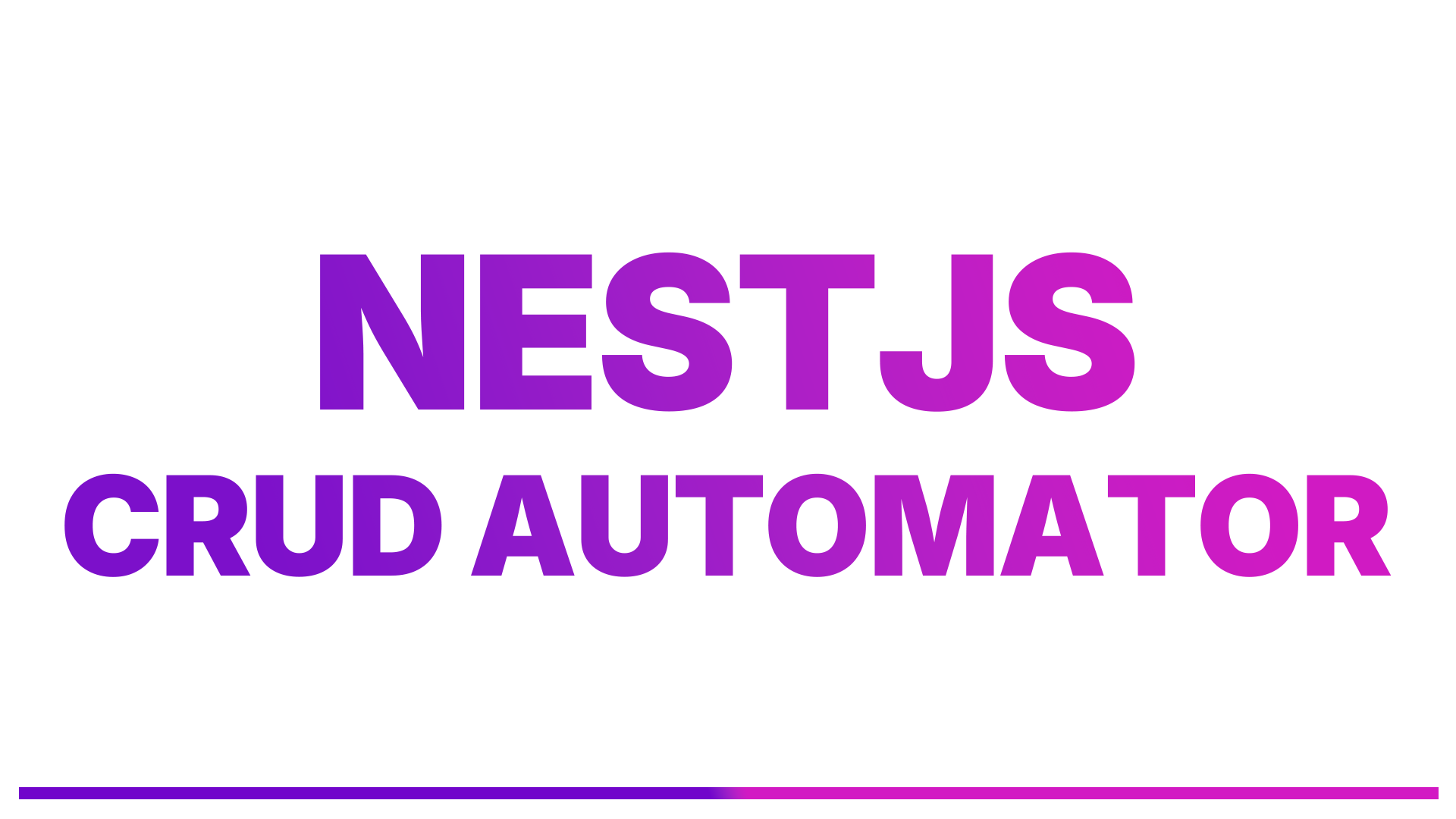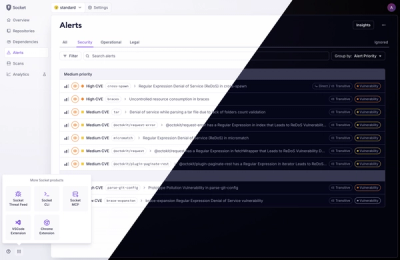
NestJS-Crud-Automator 🚀
A powerful library for automating CRUD operations in NestJS applications







📚 Table of Contents
📖 Description
NestJS-Crud-Automator is a comprehensive library designed to eliminate repetitive code when building RESTful APIs with NestJS. It provides a suite of decorators, utilities, and validation tools that automatically generate controllers, DTOs, and service methods for handling Create, Read, Update, and Delete operations. This library significantly reduces development time by providing a declarative approach to API development. By simply describing your entity properties once, the library auto-generates all the necessary boilerplate code including Swagger documentation, validation rules, and transformation logic. Perfect for developers working on data-heavy applications who want to focus on business logic rather than repetitive CRUD implementation.
The core philosophy of this library is built on four pillars: being Declarative (describe your API, don't code it), writing Minimum Code (drastically reduce boilerplate), ensuring Flexibility (override or extend any automated behavior), and guaranteeing Type-Safety (leverage TypeScript to prevent errors). It achieves this through real-time in-memory code generation, a heavy reliance on decorators for configuration, and smart conventions to reduce setup.
🚀 Features
- ✨ 🏗️ Automatic generation of controllers, DTOs, and service methods for CRUD operations
- ✨ 📝 Comprehensive Swagger/OpenAPI documentation generation for all endpoints
- ✨ ✅ Built-in validation rules with class-validator integration
- ✨ 🔄 Data transformation with class-transformer for request/response handling
- ✨ 🧩 Type-safe decorators for entity properties with rich metadata support
- ✨ 🔒 Authentication and authorization guards integration
- ✨ 🔍 Advanced filtering, sorting, and pagination for list operations
- ✨ 📚 Support for object relations with automatic loading strategies
- ✨ ⚡ Performance optimized with TypeORM integration for database operations
- ✨ 🌐 Full support for TypeScript with strong typing throughout the library
- ✨ Hooks and Subscriber System: Intercept and extend business logic at both the controller and service level.
- ✨ Dynamic and Polymorphic DTOs: Generate DTOs on-the-fly based on discriminator fields.
- ✨ Field-Level RBAC: Show/hide fields in responses based on user roles using guards.
- ✨ Request Tracing: Built-in
CorrelationIDResponseBodyInterceptor to correlate requests and logs.
- ✨ Convention over Configuration: Smart defaults for service and DTO naming to reduce boilerplate.
🛠 Installation
Install NestJS-Crud-Automator using your preferred package manager:
npm install @elsikora/nestjs-crud-automator
yarn add @elsikora/nestjs-crud-automator
pnpm add @elsikora/nestjs-crud-automator
Make sure you have the following dependencies installed in your NestJS project:
- NestJS (^9.0.0)
- TypeORM (^0.3.0)
- class-validator (^0.14.0)
- class-transformer (^0.5.1)
- @nestjs/swagger (^6.0.0)
You might need to install these peer dependencies if they're not already in your project:
npm install @nestjs/common @nestjs/swagger @nestjs/throttler typeorm class-transformer class-validator reflect-metadata
💡 Usage
Basic Usage
1. Define Your Entity
First, define your entity with the ApiPropertyDescribe decorators to provide metadata for CRUD generation:
import { Entity, PrimaryGeneratedColumn, Column } from 'typeorm';
import { ApiPropertyDescribe, EApiPropertyDescribeType, EApiPropertyStringType, EApiPropertyDateIdentifier, EApiPropertyDateType } from '@elsikora/nestjs-crud-automator';
@Entity('users')
export class UserEntity {
@PrimaryGeneratedColumn('uuid')
@ApiPropertyDescribe({
type: EApiPropertyDescribeType.UUID,
description: 'User unique identifier'
})
id: string;
@Column()
@ApiPropertyDescribe({
type: EApiPropertyDescribeType.STRING,
description: 'User name',
format: EApiPropertyStringType.STRING,
minLength: 3,
maxLength: 50,
pattern: '/^[a-zA-Z0-9_-]+$/',
exampleValue: 'john_doe'
})
username: string;
@Column()
@ApiPropertyDescribe({
type: EApiPropertyDescribeType.STRING,
description: 'User email',
format: EApiPropertyStringType.EMAIL,
minLength: 5,
maxLength: 255,
pattern: '/^[\w-\.]+@([\w-]+\.)+[\w-]{2,4}$/',
exampleValue: 'user@example.com'
})
email: string;
@Column({ type: 'timestamp', default: () => 'CURRENT_TIMESTAMP' })
@ApiPropertyDescribe({
type: EApiPropertyDescribeType.DATE,
identifier: EApiPropertyDateIdentifier.CREATED_AT,
format: EApiPropertyDateType.DATE_TIME
})
createdAt: Date;
@Column({ type: 'timestamp', default: () => 'CURRENT_TIMESTAMP', onUpdate: 'CURRENT_TIMESTAMP' })
@ApiPropertyDescribe({
type: EApiPropertyDescribeType.DATE,
identifier: EApiPropertyDateIdentifier.UPDATED_AT,
format: EApiPropertyDateType.DATE_TIME
})
updatedAt: Date;
}
2. Create a Service
Create a service with the ApiService decorator to add CRUD operations:
import { Injectable } from '@nestjs/common';
import { InjectRepository } from '@nestjs/typeorm';
import { Repository } from 'typeorm';
import { ApiService, ApiServiceBase } from '@elsikora/nestjs-crud-automator';
import { UserEntity } from './user.entity';
@Injectable()
@ApiService<UserEntity>({
entity: UserEntity
})
export class UserService extends ApiServiceBase<UserEntity> {
constructor(
@InjectRepository(UserEntity)
public repository: Repository<UserEntity>
) {
super();
}
async findByEmail(email: string): Promise<UserEntity | undefined> {
return this.repository.findOne({ where: { email } });
}
}
3. Create a Controller
Create a controller with the ApiController decorator to generate all CRUD endpoints:
import { Controller, UseGuards } from '@nestjs/common';
import { ApiController, EApiRouteType } from '@elsikora/nestjs-crud-automator';
import { UserEntity } from './user.entity';
import { UserService } from './user.service';
import { JwtAuthGuard } from '../auth/guards/jwt-auth.guard';
@Controller('users')
@ApiController<UserEntity>({
entity: UserEntity,
name: 'Users',
routes: {
[EApiRouteType.CREATE]: {
authentication: {
guard: JwtAuthGuard,
bearerStrategies: ['jwt']
}
},
[EApiRouteType.UPDATE]: {
authentication: {
guard: JwtAuthGuard,
bearerStrategies: ['jwt']
}
},
[EApiRouteType.DELETE]: {
authentication: {
guard: JwtAuthGuard,
bearerStrategies: ['jwt']
}
},
[EApiRouteType.GET]: {},
[EApiRouteType.GET_LIST]: {}
}
})
export class UserController {
constructor(public service: UserService) {}
}
Advanced Usage
Custom Validation
Add custom validators to your DTOs:
import { ApiController, EApiRouteType, EApiDtoType, AllOrNoneOfListedPropertiesValidator } from '@elsikora/nestjs-crud-automator';
@ApiController<UserEntity>({
entity: UserEntity,
name: 'Users',
routes: {
[EApiRouteType.CREATE]: {
autoDto: {
[EApiDtoType.BODY]: {
validators: [
{
constraintClass: AllOrNoneOfListedPropertiesValidator,
options: ['firstName', 'lastName']
}
]
}
}
}
}
})
export class UserController {
constructor(public service: UserService) {}
}
Request Transformation
Automatically transform request data:
import { ApiController, EApiRouteType, EApiDtoType, EApiControllerRequestTransformerType, TRANSFORMER_VALUE_DTO_CONSTANT } from '@elsikora/nestjs-crud-automator';
@ApiController<UserEntity>({
entity: UserEntity,
name: 'Users',
routes: {
[EApiRouteType.CREATE]: {
request: {
transformers: {
[EApiDtoType.BODY]: [
{
key: 'createdBy',
type: EApiControllerRequestTransformerType.DYNAMIC,
value: TRANSFORMER_VALUE_DTO_CONSTANT.AUTHORIZED_ENTITY,
shouldSetValueEvenIfMissing: true
}
]
}
}
}
}
})
export class UserController {
constructor(public service: UserService) {}
}
Handling Relations
Automatically load related entities:
import { ApiController, EApiRouteType, EApiControllerLoadRelationsStrategy } from '@elsikora/nestjs-crud-automator';
@ApiController<PostEntity>({
entity: PostEntity,
name: 'Posts',
routes: {
[EApiRouteType.GET]: {
request: {
relations: {
shouldLoadRelations: true,
relationsLoadStrategy: EApiControllerLoadRelationsStrategy.AUTO,
servicesLoadStrategy: EApiControllerLoadRelationsStrategy.AUTO,
shouldForceAllServicesToBeSpecified: false,
relationsToLoad: ['author', 'comments']
}
},
response: {
relations: ['author', 'comments']
}
}
}
})
export class PostController {
constructor(
public service: PostService,
public authorService: UserService,
public commentsService: CommentService
) {}
}
Custom DTOs
Use custom DTOs instead of auto-generated ones:
import { ApiController, EApiRouteType } from '@elsikora/nestjs-crud-automator';
import { CreateUserDto } from './dto/create-user.dto';
import { UpdateUserDto } from './dto/update-user.dto';
import { UserResponseDto } from './dto/user-response.dto';
@ApiController<UserEntity>({
entity: UserEntity,
name: 'Users',
routes: {
[EApiRouteType.CREATE]: {
dto: {
body: CreateUserDto,
response: UserResponseDto
}
},
[EApiRouteType.UPDATE]: {
dto: {
body: UpdateUserDto,
response: UserResponseDto
}
}
}
})
export class UserController {
constructor(public service: UserService) {}
}
CorrelationIDResponseBodyInterceptor: Request Tracing
To simplify debugging and request tracing in complex systems, the library provides the CorrelationIDResponseBodyInterceptor. This interceptor should be registered globally in your main.ts.
What it does:
- Intercepts all exceptions in the application (
HttpException and others).
- Looks for the
x-correlation-id header in the incoming request headers.
- If the header is found, its value is added to the body of the error response.
- If the header is not found, a new
UUID is generated, which is added to both the response and the logs (if LoggerUtility is used).
- Adds a
timestamp field to the error response body.
This allows you to link a specific client request with the logs on the server, which is invaluable when investigating incidents.
Registration: main.ts
import { CorrelationIDResponseBodyInterceptor } from '@elsikora/nestjs-crud-automator';
async function bootstrap() {
const app = await NestFactory.create(AppModule);
app.useGlobalInterceptors(new CorrelationIDResponseBodyInterceptor());
await app.listen(3000);
}
Subscriber System (Hooks): Intercepting and Extending Logic
This is the most powerful feature for extending the default behavior. It allows you to "subscribe" to events in the CRUD request lifecycle and execute your code before, after, or in case of an error in the main operation. This is an ideal solution for tasks such as:
- Auditing.
- Sending notifications.
- Complex, context-dependent validation.
- Data enrichment before saving.
- Custom error handling.
Enabling the Subscriber System
To get the subscriber system working, you need to follow three mandatory steps:
-
Import ApiSubscriberModule: This module provides the ApiSubscriberDiscoveryService, which is responsible for discovering your subscribers. You need to import it into the root module of your application.
app.module.ts
import { ApiSubscriberModule } from "@elsikora/nestjs-crud-automator";
@Module({
imports: [
ApiSubscriberModule,
],
})
export class AppModule {}
-
Make the controller "observable": Add the @ApiControllerObservable() decorator to the controller class whose events you want to monitor.
import { ApiController, ApiControllerObservable } from "@elsikora/nestjs-crud-automator";
@Controller("posts")
@ApiController({
})
@ApiControllerObservable()
export class PostController {
}
-
Make the service "observable": Similarly, add the @ApiServiceObservable() decorator to the service class.
import { ApiService, ApiServiceBase, ApiServiceObservable } from "@elsikora/nestjs-crud-automator";
@Injectable()
@ApiService({
})
@ApiServiceObservable()
export class PostService extends ApiServiceBase<Post> {
}
Without these steps, your subscriber classes will simply not be discovered and called.
Two Levels of Interception
There are two types of subscribers that operate at different levels of abstraction:
ApiRouteSubscriberBase (Controller Level): Intercepts data at the highest level. Ideal for working with the HTTP context: headers, IP address, authenticated user (request.user). The hooks of this subscriber are called before and after the main logic of the controller.ApiFunctionSubscriberBase (Service Level): Intercepts data immediately before and after calling a repository method (database). Ideal for manipulating data that is to be saved or data that has just been retrieved from the DB.
Lifecycle and Execution Order
Understanding the order in which hooks are called is critically important:
- Incoming Request
onBefore... hooks of Route subscribers (executed in priority order from highest to lowest).- Internal controller logic (transformers for
request, query, body; validators).
- A service method is called (e.g.,
service.create(body)).
onBefore... hooks of Function subscribers (executed in priority order).- The main logic of
@ApiFunction is executed (e.g., repository.save(body)).
onAfter... hooks of Function subscribers (executed in reverse priority order).- The result is returned to the controller.
onAfter... hooks of Route subscribers (executed in reverse priority order).- The response is sent to the client.
In case of an error at any stage, execution is interrupted, and the corresponding on...Error... hooks are called.
Example 1: Auditing with ApiRouteSubscriberBase
Task: Log which user created which post.
-
Create the subscriber: post-audit.subscriber.ts
import { Injectable } from "@nestjs/common";
import { ApiRouteSubscriber, ApiRouteSubscriberBase, IApiSubscriberRouteExecutionContext } from "@elsikora/nestjs-crud-automator";
import { Post } from "./post.entity";
import { User } from "../user/user.entity";
@Injectable()
@ApiRouteSubscriber({ entity: Post, priority: 10 })
export class PostAuditSubscriber extends ApiRouteSubscriberBase<Post> {
async onAfterCreate(context: IApiSubscriberRouteExecutionContext<Post, Post, { user: User }>): Promise<Post> {
const createdPost = context.result;
const currentUser = context.data.user;
if (createdPost && currentUser) {
console.log(`AUDIT: User ${currentUser.id} created Post ${createdPost.id} with title "${createdPost.title}"`);
}
return createdPost;
}
}
-
Register the subscriber: Add PostAuditSubscriber to the providers of your module.
Example 2: Data Enrichment with ApiFunctionSubscriberBase
Task: When creating a post, automatically generate a slug from the title before saving it to the database.
-
Create the subscriber: post-slug.subscriber.ts
import { Injectable } from "@nestjs/common";
import { ApiFunctionSubscriber, ApiFunctionSubscriberBase, IApiSubscriberFunctionExecutionContext, TApiFunctionCreateProperties } from "@elsikora/nestjs-crud-automator";
import { Post } from "./post.entity";
import slugify from "slugify";
@Injectable()
@ApiFunctionSubscriber({ entity: Post })
export class PostSlugSubscriber extends ApiFunctionSubscriberBase<Post> {
async onBeforeCreate(context: IApiSubscriberFunctionExecutionContext<Post, TApiFunctionCreateProperties<Post>>): Promise<TApiFunctionCreateProperties<Post>> {
const postData = context.result;
if (postData.body.title) {
postData.body.slug = slugify(postData.body.title, { lower: true, strict: true });
console.log(`ENRICHMENT: Generated slug: ${postData.body.slug}`);
}
return postData;
}
}
-
Register the subscriber: Add PostSlugSubscriber to the module's providers.
providers: [
UserService,
PostService,
PostSlugSubscriber,
],
Swagger Documentation
The library automatically generates Swagger/OpenAPI documentation for all endpoints. To enable it in your NestJS application:
import { NestFactory } from '@nestjs/core';
import { DocumentBuilder, SwaggerModule } from '@nestjs/swagger';
import { AppModule } from './app.module';
async function bootstrap() {
const app = await NestFactory.create(AppModule);
const config = new DocumentBuilder()
.setTitle('Your API')
.setDescription('API description')
.setVersion('1.0')
.addBearerAuth()
.build();
const document = SwaggerModule.createDocument(app, config);
SwaggerModule.setup('api', app, document);
await app.listen(3000);
}
bootstrap();
Custom Filtering
The library provides advanced filtering capabilities for list endpoints:
This query would search for users with "john" in their username and created between Jan 1 and Dec 31, 2023.
🛣 Roadmap
Roadmap
| Core CRUD operations | ✅ Done |
| TypeORM integration | ✅ Done |
| Swagger/OpenAPI documentation | ✅ Done |
| Validation with class-validator | ✅ Done |
| Transformation with class-transformer | ✅ Done |
| Advanced filtering for GET_LIST operation | ✅ Done |
| Authentication guard integration | ✅ Done |
| Request/response transformers | ✅ Done |
| Relation loading strategies | ✅ Done |
| Custom validator integration | ✅ Done |
| Pagination support | ✅ Done |
| Error handling with standardized responses | ✅ Done |
| Support for TypeScript decorators | ✅ Done |
| Support for ESM and CommonJS modules | ✅ Done |
| Subscriber System | ✅ Done |
| MongoDB support | 🚧 In Progress |
| GraphQL integration | 🚧 In Progress |
| Support for soft deletes | 🚧 In Progress |
| Role-based access control | 🚧 In Progress |
| Cache integration | 🚧 In Progress |
| Audit logging middleware | 🚧 In Progress |
| Bulk operations (create many, update many) | 🚧 In Progress |
| Query complexity analyzer | 🚧 In Progress |
| Rate limiting enhancements | 🚧 In Progress |
| Custom parameter decorators | 🚧 In Progress |
❓ FAQ
Frequently Asked Questions
How does NestJS-Crud-Automator compare to @nestjsx/crud?
While @nestjsx/crud provides similar functionality, NestJS-Crud-Automator offers more comprehensive TypeScript integration, better Swagger documentation, and more flexible customization options. It's designed from the ground up to work with the latest NestJS and TypeORM versions.
Can I customize the generated endpoints?
Yes! The library provides multiple ways to customize your endpoints:
- You can disable specific routes
- Add authentication guards to specific routes
- Customize DTO validation and transformation
- Add custom request validators
- Override the auto-generated DTOs with your own
Yes, the GET_LIST operation automatically includes pagination with limit and page parameters, and returns count, currentPage, totalCount, and totalPages in the response.
How is filtering implemented?
Filtering is implemented using a flexible operator-based approach that supports various operations like equals, contains, greater than, less than, between, etc. Filters can be applied to any property of your entity.
Can I use this with NestJS microservices?
Yes, while the library primarily targets REST APIs, you can use the generated DTOs and validation logic in microservice implementations as well.
Does it support file uploads?
The core library doesn't include file upload functionality, but you can easily extend the generated controllers to add file upload capabilities using NestJS's built-in features.
Is it compatible with custom database repositories?
Yes, as long as your repository follows the TypeORM Repository pattern, it will work with NestJS-Crud-Automator.
🔒 License
This project is licensed under **MIT License
Copyright (c) 2025 ElsiKora
Permission is hereby granted, free of charge, to any person obtaining a copy
of this software and associated documentation files (the "Software"), to deal
in the Software without restriction, including without limitation the rights
to use, copy, modify, merge, publish, distribute, sublicense, and/or sell
copies of the Software, and to permit persons to whom the Software is
furnished to do so, subject to the following conditions:
The above copyright notice and this permission notice shall be included in all
copies or substantial portions of the Software.
THE SOFTWARE IS PROVIDED "AS IS", WITHOUT WARRANTY OF ANY KIND, EXPRESS OR
IMPLIED, INCLUDING BUT NOT LIMITED TO THE WARRANTIES OF MERCHANTABILITY,
FITNESS FOR A PARTICULAR PURPOSE AND NONINFRINGEMENT. IN NO EVENT SHALL THE
AUTHORS OR COPYRIGHT HOLDERS BE LIABLE FOR ANY CLAIM, DAMAGES OR OTHER
LIABILITY, WHETHER IN AN ACTION OF CONTRACT, TORT OR OTHERWISE, ARISING FROM,
OUT OF OR IN CONNECTION WITH THE SOFTWARE OR THE USE OR OTHER DEALINGS IN THE
SOFTWARE.**.











